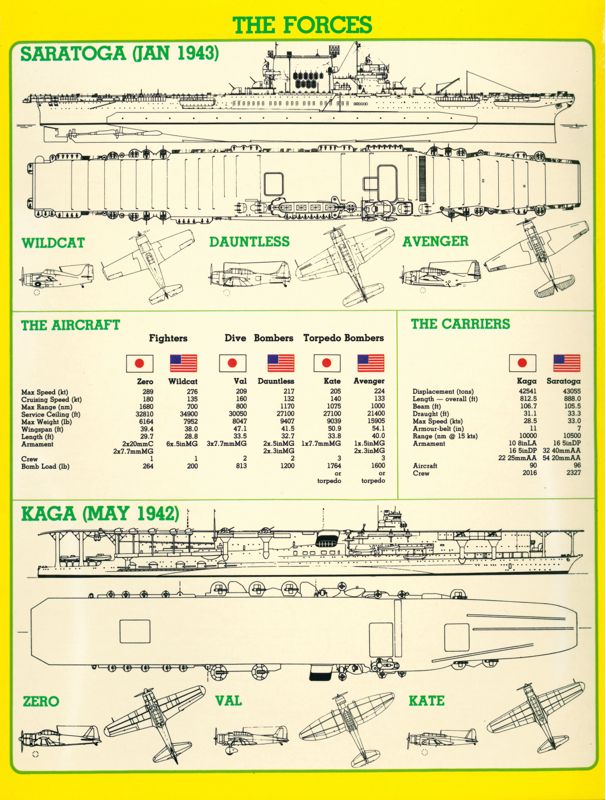
Carriers at War by Ian Trout and Roger Keating, published by SSG, Australia
First release: November 1984 on Apple II
Genre: Naval Operations
AARs: Coral Sea, Midway, Demise of the Empire, Japan Swipes South
Average duration of a campaign: 1 – 2 hours
Total time played: Around 10 hours
Complexity: Medium (2/5)
Final Rating: ☆☆☆
Ranking at the time of review: 13/157
Context – It is dismaying that after spending so much time both on the Carriers at War AARs and on Reach for the Stars, I have so little to say about the history of Carriers at War; alas Roger Keating only had scant recollection of how the game came to life. Immediately after finishing Reach for the Stars, the two founders and only employees of SSG Ian Trout (designer) and Roger Keating (programmer) moved to their next game. The exciting military event of the early 80s was, of course, the Falklands Wars and the duo started a game titled Task Force South. However, Trout quickly realized that even if they accurately simulated the Falklands War – not granted given the lack of documentation and the complexity of managing both sea and ground – it was a narrow scope with little replayability, exactly the opposite of Reach for the Stars. The game was soon abandoned.
Unsure of how long they could pay themselves with Reach for the Stars (a long time, but they did not know it yet as sales started slowly), the duo looked for an easy theme: the Pacific War. As they explain in the “Designer’s Rambling” included in the manual: “Carriers at War would only take a few months to finish since we knew so much about the period. Well, eleven months later we know now what we didn’t know when we started.” The documentation must indeed have been monumental, given the game includes different stats for also every ship or plane that participated in the carrier battles of the Pacific War, in addition to the orders of battle themselves, something made possible by separating the game between a “Master [code]disk” and a “scenario disk”. Even then, Keating squeezed every byte possible (out of 64K) in service of the code, with several features rejected for lack of memory – and it shows.
Initially developed on Apple II, Keating immediately ported the game to Commodore 64 and both platforms had a simultaneous release around November 1984 for exactly 50 USD. The box, a cardboard folder, included, in addition to the disk, a game manual, an editor manual, a scenario list (with map) and the reference chart at the top of this article. The game itself includes 5 scenarios (Pearl Harbor, Coral Sea, Eastern Solomons, Santa Cruz, Philippines) – the first one was a tutorial and the last one closer to a history lesson than an entertaining scenario. If that was not enough, the game included a scenario designer, something that had been common in 1980 and 1981 but had all but disappeared in 1984. Being two former educators, Keating and Trout believed in “learning by doing” and the scenario designer gave all the instructions necessary to create a Raid on Ceylon scenario, that regretfully I did not play. It was a lot of content for 1984, but SSG would deliver more.
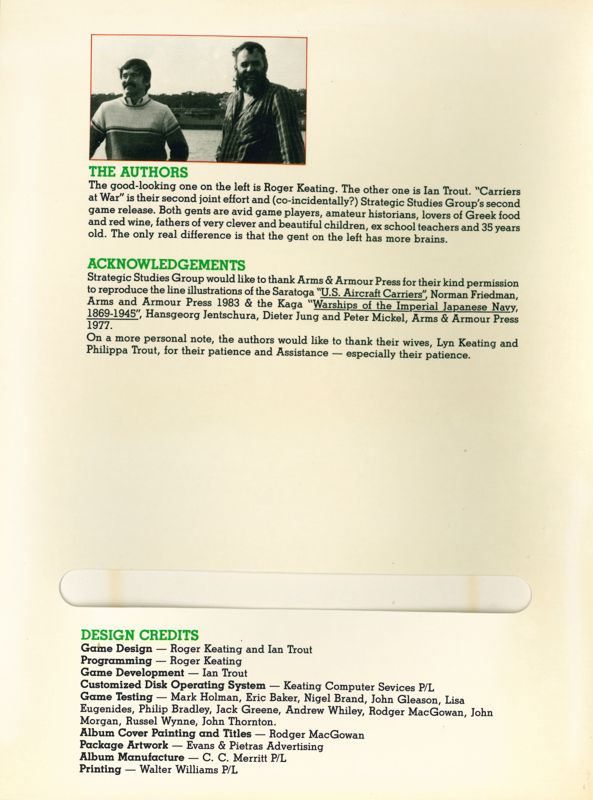
Over 1985, Trout pondered how to sell add-ons for their games – mail-order being deemed too expensive. Eventually, Trout chose to publish a magazine, Run5, with all the data needed to create scenarios. The first issue was published in January 1986 and includes several scenarios, rule errata and the beginning of a list of the stats of all WW2 ships- a project that would span over 3 issues. Over time, the magazine would publish 8 new scenarios: Wake Island (alt. history), the three scenarios of Japan Swipes South, Leyte Gulf (a user submission), Gilbert’s Strike (alt. history, possibly another user submission), Pedestal (the only Mediterranean scenario) and finally “The Final Countdown” based on the movie of the same name with, yes, zeros, F-14 and nuclear carriers.
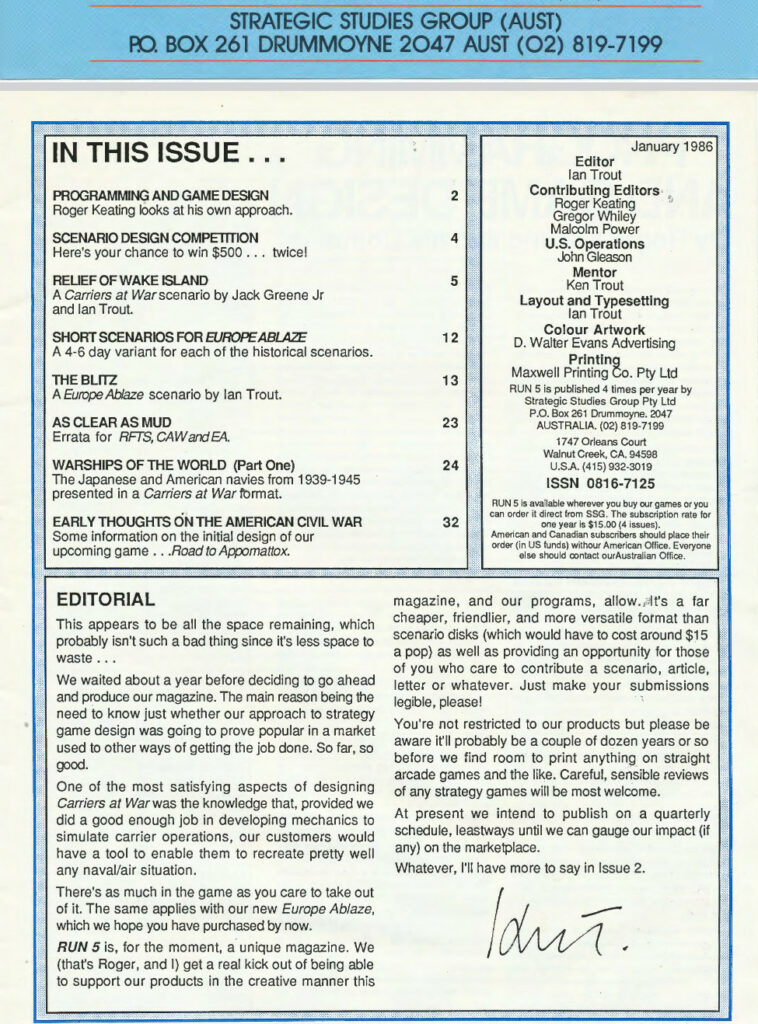
Traits – Carriers at War is the 9th Pacific War theme game covered on this blog. Thus far, the alternative has been between beer-and-pretzel games, quick to play but lacking in historical depth (Avalon Hill’s Midway Campaign, Ken Wright’s Pacific War), or simulationist games that cluttered you with pointless tasks, for instance Gary Grigbsy’s Carrier Forces – a few games fell on the side as being neither fast to play nor simulations, with Alan Steele’s Battle for Midway the worst offender in that category.
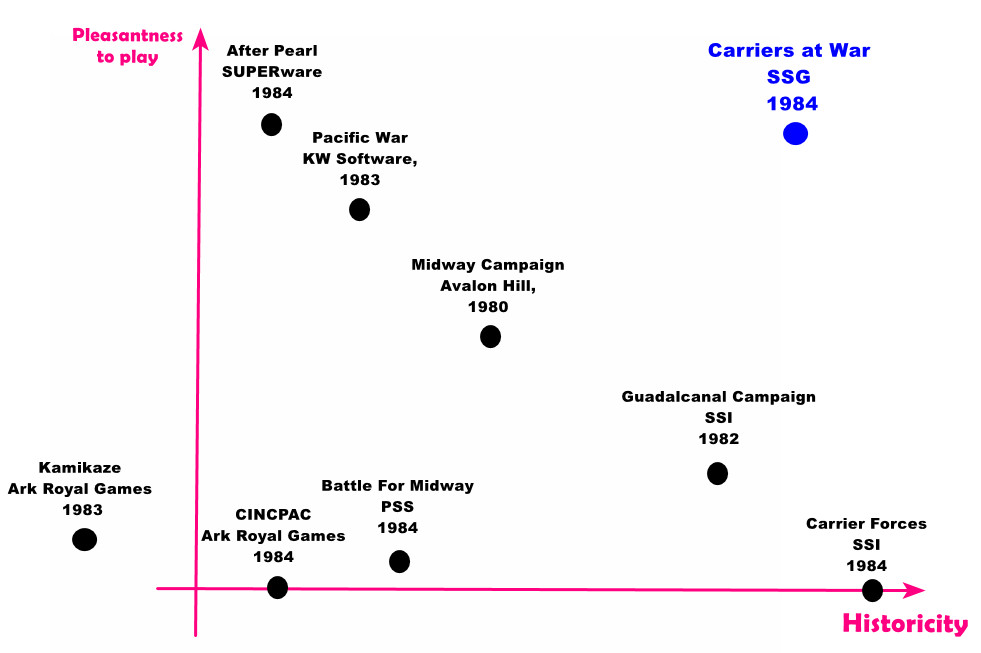
Carriers at War is the first that’s fast to play (for wargames anyway – 45-60mn by battle on a modern computer) but historically extremely detailed – more so than even Carrier Force. This was possible by making the game real-time with pause (so uneventful moments would pass in seconds) but also by keeping only the most necessary decisions in the game. Ultimately, there are very few actions “left” for the player – and that’s good:
- Fleet movement, with no way to split or merge them (disable ship detach automatically from the rest of the fleet). Even then, most of the movement can be automated by ordering a fleet to escort, support or cover another allied fleet or to go after an enemy target – this leaves very few cases where a player will want “free movement” – typically this should be used for carrier groups,
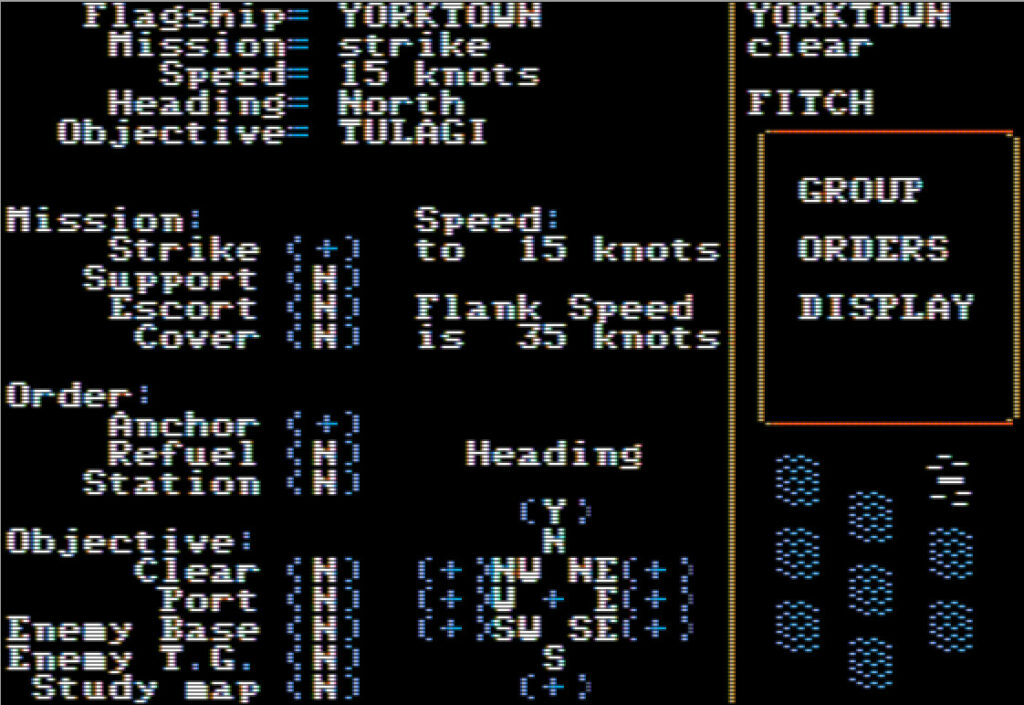
- The direction your scout planes are going to search, which honestly the perfect compromise between games that give you no control at all over your scouts and those that expect you to micro-manage them every turn.
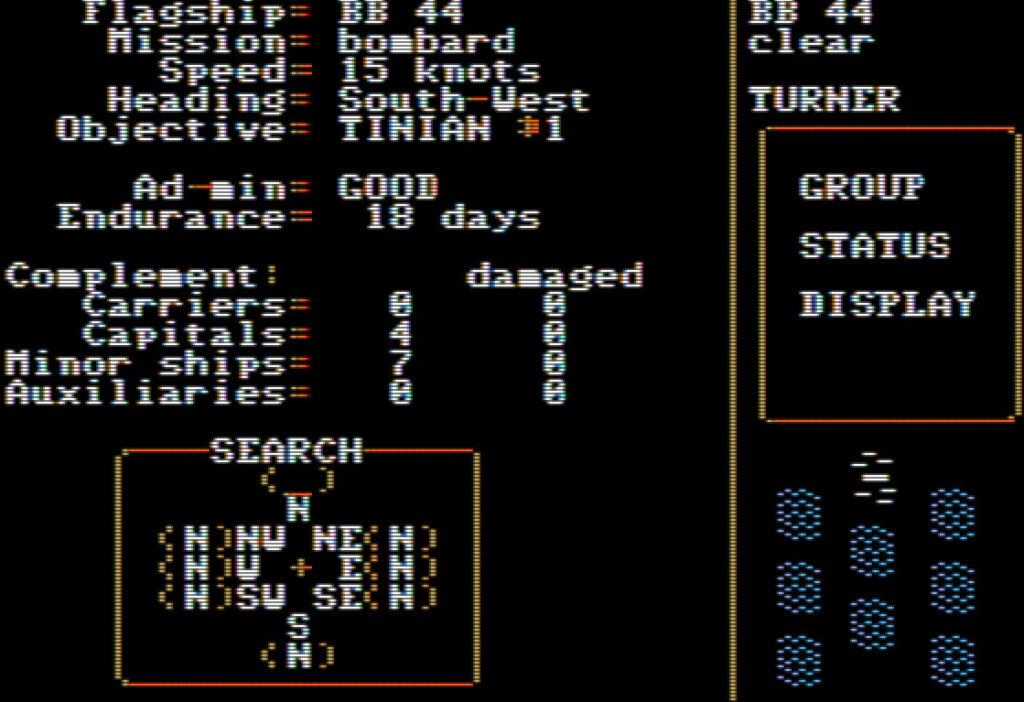
- Finally, the plane commands: preparing them on deck and launching them, with the latter including the option to send squadrons individually or in groups (which is slower), and another option to have the fighters focus on escort or focus on strafing the targets. Carriers at War also removed a lot of frustration found in other games by not letting you send planes if they won’t be able to return either to the carrier or to a land base.
Thanks to this streamlining, a lot of clutter is removed from the Pacific War: you don’t have to create your air groups or attach/detach individual ships to your fleets, and you don’t have to move dozens of fleets, planes or individual floatplanes hexagon after hexagon. Even better, you can delegate part of the game to the computer (like I usually did for the airbases) so you can focus on the juicy parts. I reckon this is why Carriers at War is good: you are the Admiral of a fleet, not an admiral/pilot/navigator/aircraft handling officer – and I don’t feel it sacrificed a lot of freedom of action with this ruleset. Overall, I just wish I could change the routes of transport/bombardment fleets and the number of planes allocated to CAP and scouting missions.
Now that I have covered Carriers at War’s greatest strengths, I have to get into its greatest weakness: lack of communication. The game takes into account a bazillion parameters, but barely communicates any to you. The most egregious cases are the submarines: they exist, but they are invisible (including yours!) – the only way to find their location is to open the editor!
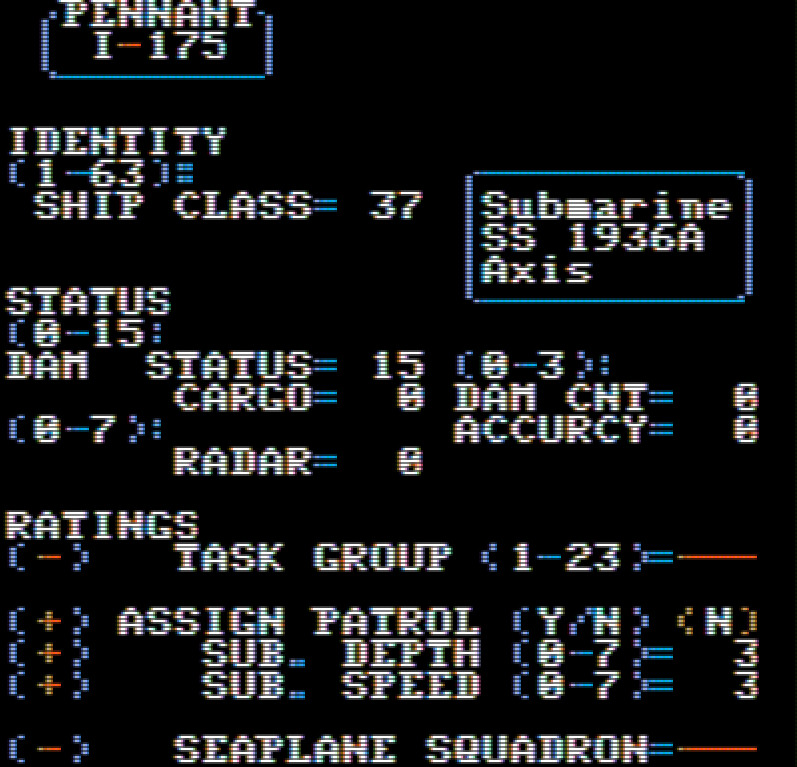
The game deals with anchor points (for seaplane tenders) and coastwatchers the same way: they exist, you just don’t know where. For seaplane tenders, this can be deadly as those anchor points are, for some unfathomable reason, the only places from which seaplane tenders can launch seaplanes. Given battleships and cruisers can’t anchor, either they don’t have this constraint or their seaplanes are useless.
Submarines, coast watchers and anchor points are the most extreme cases of poor communication, but the issue permeates the whole game. For instance, the manual tells you how the “quality” of the intel on the enemy fleet depends on who did the detection (“Sighting reports on enemy task groups may be generated by individual search planes, squadrons, submarines, friendly task groups, coastwatchers and friendly land bases. Sightings made by aircraft are generally the least reliable, especially if the enemy task group is in the open ocean”) but the game does not tell you who did the detecting – you just learn that an enemy fleet has been spotted! I know Keating squeezed every single byte he could use, but was there no way to sacrifice, say, “submarine depth” or maybe some of the 7 data points used to evaluate the combat capacity of planes to save a few bytes, and then use these to send the simple message “spotted by a plane/submarine/cruiser“? This would have increased my enjoyment of the game so much.
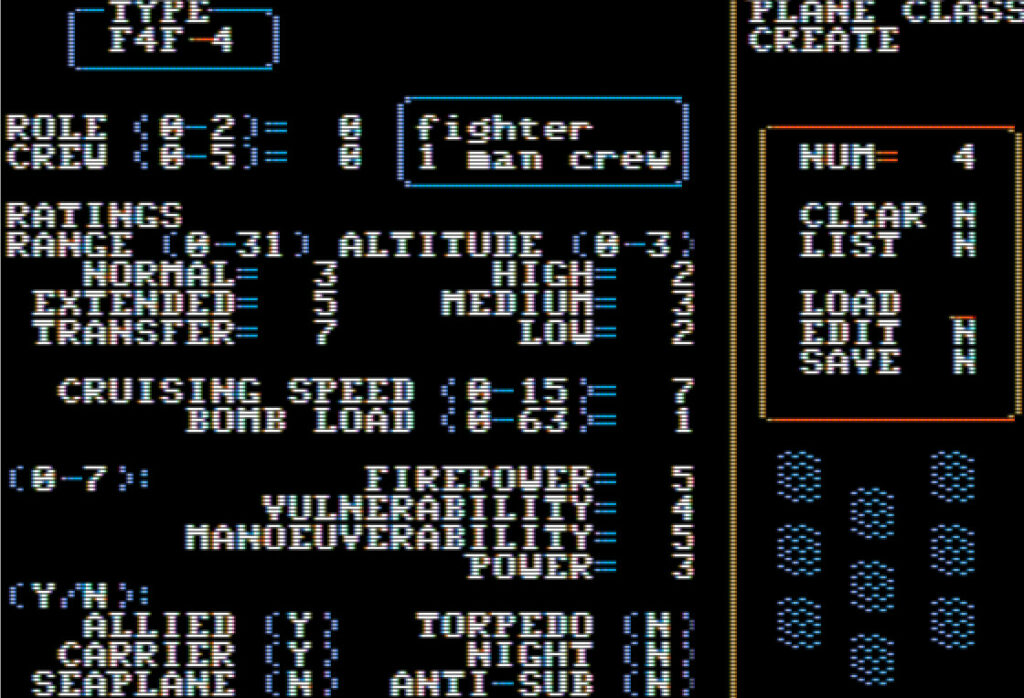
It can get even more absurd. The game has no battle report of any kind: your squadron has a small animation around it when it attacks an enemy, and that’s all. I find it incredibly satisfying to read battle reports and discover that I sank the USS Wasp and crippled the USS San Juan, but in Carriers at War there is… nothing. All you can do is check the variation in the highly unreliable “Estimated Loss Report“. Said like this, it reads like a choice of realism-over-fun decision from Trout, but frustratingly you have no battle reports when your ships are attacked either – if you don’t check the report you may believe your carriers are still pristine. At least, in the case of air attacks, you can see the enemy plane icons coming and leaving the sky above your fleet; on the other hand for surface combat or submarine attacks, there is no message or notification of any sort – one moment your ships are there and the following moment they are damaged or sunk!
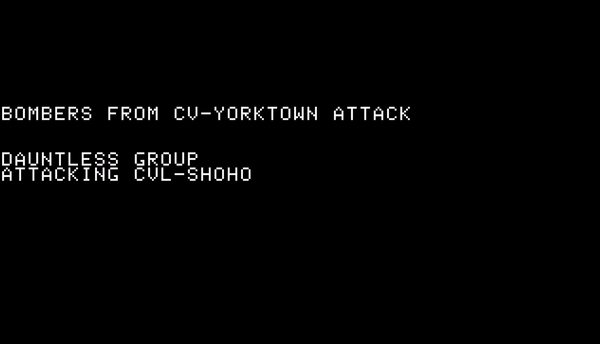
I don’t want to end this section on a sour note – the game’s strengths largely overcome its weaknesses. As the game is comparatively quick to play, it is acceptable to check your carriers and transports every hour to see if they have been damaged, and the other ships can be largely ignored as they have marginal impact on the game, if any. Still, it dampened my enjoyment of the game.
Did I make interesting decisions? Yes! Generally, carrier warfare is largely luck-based: you stack the odds in your favour with your tactics and positioning and hope that the roll of the dice is in your favour and that you detect the enemy fleet before they detect you. However, Carriers at War feels fairer than other games on the theme: recon does its job well, and so enemy fleets usually detect each other significantly before they are within range, giving you options. Even when they don’t, that’s usually not due to luck but to an objective factor that you could have mitigated: night, bad weather or isolated carriers not supported by an air base. Granted, they’re still some luck involved in detection and attacks, but when things go South, I can usually pinpoint a poorly thought-out choice that backfired.
Final rating: ☆☆☆. Reach for the Stars was seminal for the 4X genre, and similarly, Carriers at War shows how a carrier warfare game is done, but alas its lack of feedback and general dryness prevents it from becoming a complete classic.
Reception
Carriers at War received a throng of reviews – so many it would be pointless to list them all. All of them without exception praised the depth of the game and most used superlatives like “exceptional“, “terrific” or “the best [wargame] available“. Few reviewers, however, fail to mention the flaws of the game: typically the lack of information and visual eye candy during combat and the unclear ruleset. Jeff Seiken for instance reckons that the game streamlines too much, mentioning submarines and scouts. He also complains that the ruleset is unclear (“for example, the rules tell you how to read the weather menu, but never describe — even in general terms — the effects that weather will have on operations“). Still: “the true measure of a good game is whether its strengths not only outnumber, but also offset, its weaknesses. Carriers at War passes this test with ease. It captures the essence of carrier warfare — the importance of planning, maneuver, timing, and steady nerves.”
Another common theme found in reviews is that Carriers at War, while great on paper, is just too complex for non-wargamers. This is for instance Graham Cousens’ position in the Australian Apple Review (March 1985): “What’s the weather? Where are your bases? The enemy’s bases? Weapon allocation? Damage statistics? Firing accuracy? Base facilities? Ship vulnerability? And so on and so on and so on. For a non-war-gamer its all too much.” This is also the take of Brian Murphy for InCider (September 1986): “It seems as if you’ll never reach the point at which the game system becomes second nature, letting you concentrate on the problems of command. You can eventually get there, but it’s a long, hard trek. Frankly, I prefer Gary Grigsby’s SSI naval games“.
Speaking of Gary Grigsby’s games – a plurality of reviewers compared Carriers at War to Carrier Forces, most notably Bill Nichols in the reference magazine Computer Gaming World in April 1985. After conceding the advantage to Carrier Forces in the “graphics” category, Nichols concludes univoqually on the rest: “Carriers at War is the best game available on World War II carrier operations. It is, perhaps, the best wargame of 1984 on any topic.” This conclusion did not sit well with everyone at Computer Gaming World, and an editor note was appended at the end of Nichols’ review:
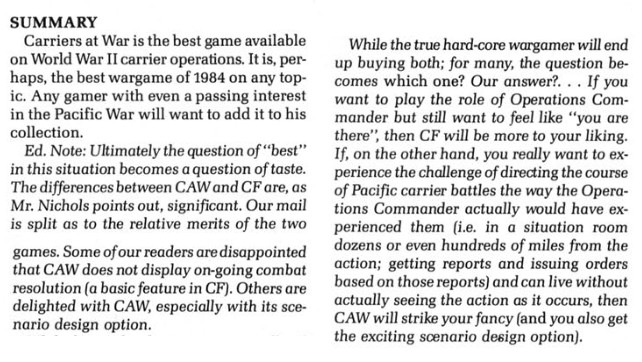
Carriers at War, according to Keating, even more successful than Reach for the Stars, at least in the short term. It earned the 1984 Charles S. Roberts’ Award for Best Adventure Game, which shows that no one took the time to explain to Charles S. Roberts what an adventure game was after Knights in the Deserts won the prize in 1983. I chuckle at the thought of the typical 1984 adventure gamer trying to make sense of the game (SEND PLANES? SEND FIGHTERS? TAKE OFF PLANES? This is a terrible parser, nothing seems to work!). Similarly, wargame specialist Evan Brooks considered the game a classic, giving it 4 stars in his first review of all wargames in 1987, then again in 1991, only downgrading the game to 3 stars in 1993, almost 10 years later. By then, SSG had released a second edition of Carriers at War in 1992. I don’t know whether I will ever reach that year, but if I abandon my project before that I will make sure to check the game.